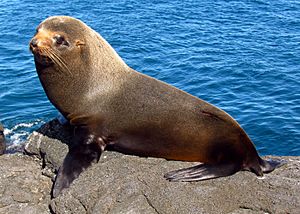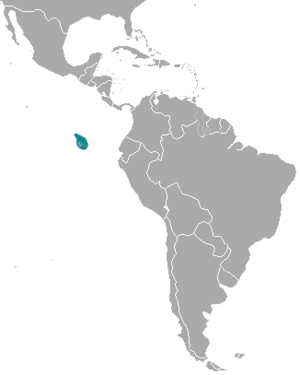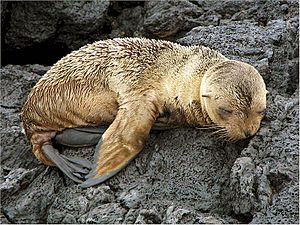Galápagos fur seal facts for kids
Quick facts for kids Galápagos fur seal |
|
|---|---|
 |
|
| Male, Santiago Island | |
| Conservation status | |
| Scientific classification | |
| Genus: |
Arctocephalus
|
| Species: |
galapagoensis
|
 |
|
| Galápagos fur seal range | |
The Galápagos fur seal (Arctocephalus galapagoensis) is a type of fur seal. It is the smallest of all the seals that have visible ears. These special seals live only in the Galápagos Islands in the eastern Pacific Ocean. In the 1970s, there were about 30,000 of them. However, their numbers have been going down since the 1980s. This is because of things like pollution, diseases, and their small living area. People used to hunt them a lot, but the government of Ecuador has protected them since 1934.
Contents
What They Look Like
Galápagos fur seals are the smallest eared seals. When they are born, they have black fur. Later, they shed this fur and get a lighter brown coat as they grow up.
Male and female Galápagos fur seals look quite similar. Males are usually up to two times heavier than females. They are also about 1 to 1.3 times longer. A male seal is typically about 1.5 meters (5 feet) long and weighs around 64 kilograms (140 pounds). Females are smaller, about 1.25 meters long and weighing about 27 kilograms (60 pounds).
These seals have large eyes. This helps them hunt for food at night. Galápagos fur seals look a lot like Galápagos sea lions. Here are some ways to tell them apart:
| Galápagos Fur Seal | Trait | Galàpagos Sea Lion |
|---|---|---|
| Generally smaller | Size | Generally larger with a longer body |
| Thicker fur coat that looks black when wet, but golden when dry | Pelt | Less underfur and a darker color |
| Larger | Eyes | Smaller |
| Stick out from the head | Ears | Flatter and closer to the head |
| Found in more shaded, rocky areas | Where they live | Found on beaches and piers |
Population
During the 1800s, many Galápagos fur seals were hunted for their fur. This caused their population to drop a lot. Luckily, their numbers grew back in the 1900s. By the late 1970s, there were about 30,000 of them.
Even with protection, their population has changed due to other environmental issues since the late 1980s. Most fur seals are found in the northern and western parts of the Galápagos Islands. While they usually stay in the islands, some have been seen in Ecuador and southern Mexico during El Niño events.
Where They Live
The Galápagos fur seal lives only in the Galápagos Islands, which are part of Ecuador in South America. You can find them on almost all the islands. They usually stay near the coast where there are rocky ledges and cracks. These spots offer shade, which is important in the warm climate.
These seals do not travel far from their homes. Females with young pups tend to stay close to their colony. They only go on short trips to find food. However, some Galápagos fur seals have recently been seen in Mexico and Guatemala.
Reproduction and Life Cycle
Galápagos fur seals live in large groups on the rocky beaches of the islands. During breeding season, which is from mid-August to mid-November, male seals claim areas of the beach. The busiest time for births is in late September and early October. Each female seal that is ready to have a pup will choose a spot in one of these areas.
Raising Pups
Galápagos fur seals have a very slow rate of having babies. It also takes a long time for mothers to raise their pups until they can live on their own. Females usually have only one pup at a time. A mother stays with her new pup for about a week before she leaves to find food. She then comes back to feed her pup for a few days before going on another hunting trip.
Mothers recognize their pups by their smell and sounds. Pups also learn to identify their mothers by special calls. It is very important for mothers and pups to recognize each other. This is because mothers only feed their own pups. They often push away other pups that try to get milk. Pups that lose their mothers usually try to sneak milk from other sleeping or calling females. But this is often not enough food, and these orphaned pups usually die within a month.
Sibling Rivalry
Fur seal pups drink their mother's milk for about 18 months. Sometimes, if food is scarce, they might keep drinking milk for up to two or three years. This means that sometimes a new pup is born while an older sibling is still drinking milk.
Whether the younger pup survives depends a lot on how much food is available. In good years, when there is plenty of food, very few younger pups die. This is similar to pups who don't have older siblings. But in years when food is hard to find, about 80% of younger pups with older siblings die within a month. This strategy helps the mother if the first pup dies, or if conditions turn out to be better than expected.
Because food can be hard to find and pups drink milk for a long time, there can be fights between siblings. Mothers often step in, sometimes aggressively, when an older sibling bothers a newborn pup. Mothers might bite or lift the older pup roughly. This can sometimes cause small injuries. Over time, the mother's aggression towards the older sibling lessens.
Even without direct fighting, older siblings can still harm younger ones by taking most of the milk. The older pup usually drinks first and only lets the younger one drink after it has had enough. This often leaves very little milk for the younger pup, and they can die from not getting enough food.
During times when there is very little prey, like during an El Niño event, sibling conflict gets worse. El Niño brings warmer water and less food. Older seals try very hard to keep drinking milk, and mothers might neglect their younger pups.
Male Competition
Male fur seals compete for females by setting up territories on the beaches. These beaches are important places for females to have their pups. Male territories are quite large, averaging about 200 square meters.
What They Eat and Who Eats Them
Galápagos fur seals mainly eat fish, squid, and shellfish. They usually hunt close to shore and near the surface of the water. However, they have been seen diving as deep as 169 meters (554 feet). They mostly hunt at night because their prey is easier to catch then.
In normal years, there is enough food for everyone. But during an El Niño year, food becomes very scarce. Many young pups die during these years. Adult seals feed themselves before their young. In very tough El Niño years, most of the young seal population can die.
Galápagos fur seals have almost no regular predators. Sometimes, sharks and orcas are seen eating them, but this is very rare. Sharks and orcas are the main predators for most other seal species. However, their usual travel paths do not often cross the Galápagos Islands.
Protecting the Seals
Threats from Humans
The Galápagos Islands have many tourists. However, tourism is carefully managed by the government of Ecuador. Boats near the islands could also hit the fur seals, which can be deadly. In the past, people hunted Galápagos fur seals for their fur. This hunting stopped when the Galápagos Islands became a national park in 1959, and the seals were protected by law.
Environmental Threats
The fur seals' natural home is limited, which makes them more at risk from environmental changes. Other dangers include oil spills and boat crashes. Oil spills would be very bad for fur seals because their thick fur helps them stay warm. If their fur gets covered in oil, they can't stay warm. Ships of different sizes travel near the islands, and they could spill oil.
In the past, wild dogs on Isabela Island were known to kill Galápagos fur seals. But all the wild dogs on that island have now been removed, so the seals are safe from this threat. Today, the biggest threats to Galápagos fur seals are climate change, including warmer oceans and El Niño weather events. Other indirect threats are ocean pollution, diseases spreading from other animals, and getting caught accidentally in fishing nets.
Pollution and Diseases
Animals like rats, pet dogs, and wild cats can carry diseases that might spread to Galápagos fur seals. Even though the seals don't live very close to many domestic animals, wild cats are found around the islands. Tests on these dogs and cats showed they carry many germs. This means the fur seals could be at risk of getting sick from them.
Scientists also found that Galápagos fur seals and sea lions had signs of certain bacteria. This could have caused deaths in sea lions in the past. If sea lions get infected in the future, it could affect fur seals too. This is because sea lions move around, which could spread diseases to many fur seal groups.
The health of Galápagos fur seals is also at risk from chemical pollution. This includes chemicals from oil spills and other harmful substances called POPs (Persistent Organic Pollutants). Two common POPs found in fur seals are toxic and build up in their bodies. This was discovered when different pesticides were found in the seals, raising concerns for their health.
Status
The population of Galápagos fur seals has been going down since the 1800s. Thousands were killed for their fur by hunters. In 1959, Ecuador made strict laws to protect these animals. The government made the Galápagos Islands a national park, and since then, no major hunting has happened.
Despite these laws, another big problem happened during the 1982–1983 El Niño event. Almost all the seal pups died, and about 30% of the adult seals were lost. Since 1983, no major disaster has caused their population to drop so much.
What is Being Done
The Galápagos fur seal is listed as an endangered species by the IUCN Red List. This is because their population numbers have changed a lot and gone down over the last 30 years. Luckily, the seals and most of their home are now protected by Ecuadorian law. They are also protected under a special law for the National Park and Galápagos Marine Reserve.
This National Park was created in 1959. This meant better management and protection for the area and the waters around it, where fishing is not allowed for many miles. Since they live in a national park, there can be a lot of tourism, but it is well controlled, so the seals are safe. The National Park Service has also helped control the wild dogs that used to attack and kill many Galápagos fur seals.
In 1991, Ecuador started a plan to protect marine mammals in the southeast Pacific, which includes Galápagos fur seals. People are now studying the danger of plastic pollution to wildlife, including fur seals, through a program called "Plastic Pollution Free Galapagos." The Galápagos Islands were also one of the first places named a Natural World Heritage Site, which helps protect the islands even more. However, Galápagos fur seals will always face threats because they live in a limited area across the islands.
See also
 In Spanish: Lobo peletero de las Galápagos para niños
In Spanish: Lobo peletero de las Galápagos para niños





